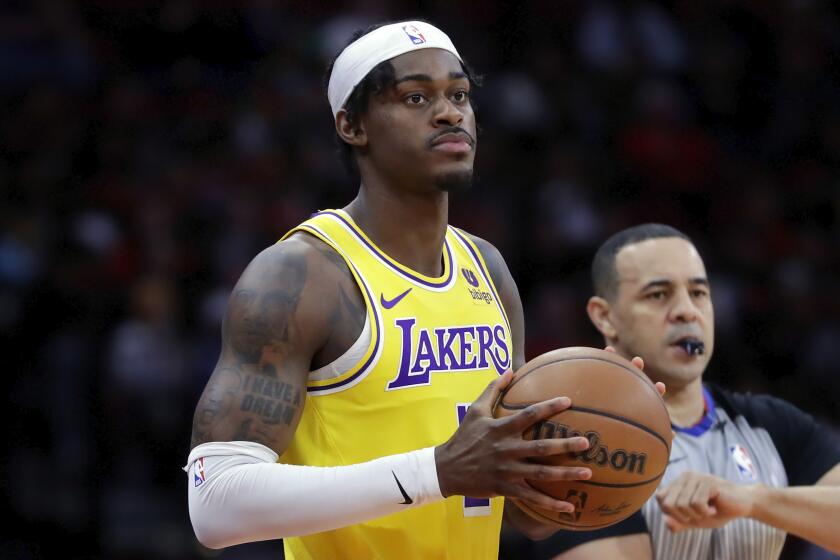Howard’s Comeback Provides Inspiration for Stanford Defense
- Share via
When an MRI reveals damage to the knee, most athletes take it easy and wait for the injury to heal. Not Willie Howard of Stanford. He defies medical logic.
“It was how the MRI looked versus how a guy really felt,” Cardinal trainer Dale Rudd said. “Willie was able to play despite what the MRI says. He’s an amazing athlete.”
Howard, a 6-foot-4, 290-pound defensive tackle, was given clearance by doctors to suit up for Saturday’s Rose Bowl despite his right knee’s uncertain status. He didn’t just play, he was all over the field pushing around Wisconsin linemen and chasing down ballcarriers.
He was an inspiration for his teammates and helped a much-maligned defense earn its share of respect in a 17-9 loss.
“In my mind and my heart, if I got in there, I wasn’t going to play one play,” Howard said. “I needed to go out there and give it all I’ve got. Because I kept running when I was hurt and doing conditioning, it gave me an opportunity to stay in there and mess up some offensive calls.”
The first test for Howard came on Wisconsin’s opening play. Badger tackle Chris McIntosh, a 310-pound Outland Trophy finalist, had a greeting for Howard.
“He put it on me and I said, ‘If I’m going to be able to withstand this, I’m going to be able to play the whole game,’ ” Howard said. “I kept going and going.”
On the next play, Howard tackled quarterback Brooks Bollinger for a five-yard loss.
Throughout the game, Stanford trainers kept asking, “How are you doing?” Howard responded by flashing the thumbs-up sign and rarely came out of the game. Teammates saw Howard’s resiliency and their energy and intensity increased.
By halftime, Stanford held a 9-3 lead and had limited running back Ron Dayne to 46 yards in 12 carries. The defensive line effectively took on Wisconsin’s big, strong offensive line and allowed inside linebackers Sharcus Steen and Marc Stockbauer to make most of the tackles. Steen finished with 14 tackles, Stockbauer 13.
“Especially in the first half, our run defense was pretty solid,” Stanford Coach Tyrone Willingham said. “[Dayne] may have had one long run in the first half, but other than that, the majority of his runs were two, three yards. Any time you limit a truly great back, as he is, to that kind of yardage, I think you are positioning yourself to win.”
Only on a 64-yard run by Dayne on the second play of the third quarter did Stanford’s defense break down. Dayne found a gap up the middle and didn’t stop running until cornerback Frank Primus dragged him down from behind at the 11. Two plays later, Dayne scored the go-ahead touchdown.
Stanford recorded eight tackles for losses. Cardinal defenders ignored all the talk of their liabilities.
“We didn’t care what anybody was saying,” strong safety Tim Smith said. “We knew how we felt as a group.”
Howard, who had 10 sacks and 19 tackles for losses during the regular season, damaged his anterior cruciate ligament against Notre Dame on Nov. 27 and didn’t practice until last Tuesday. His big contribution had been his appetite. He consumed eight slabs of prime rib in the Beef Bowl and won a spicy chicken-wing eating contest.
He quietly, built up his strength and regained his mobility working out on his own. But no one, from head trainer Rudd to defensive coordinator Kent Baer, expected Howard to play the entire game.
“I think we were all [amazed],” Baer said. “He was never totally cleared until a day or two ago. He’s real tough. Everybody rallies around him. He plays with a lot of intensity. Everybody believes in him. He gave a tremendous effort. That’s what this game is all about. You live all your life to get into a game like this and you don’t want to pass it up.”
Added Steen: “Willie is a phenomenal athlete, a phenomenal player, a phenomenal leader. There was no doubt in my mind, no matter how hurt he was, that he was going to play.”
Howard sensed other players were drawing strength from him. He decided he could not afford to let anyone see him hurting.
“My focus was to win the game and to give as much juice to the team as I can,” he said. “At any time if I showed signs of weakness, that would have lowered the team.”
In the end, Stanford’s defense proved it was better than many people thought.
“I think the loss hurts,” Howard said, “but for us to lose [by eight points] to a team that was supposed to dominate us shows a lot of character. We put ourselves in position to actually win.”
More to Read
Go beyond the scoreboard
Get the latest on L.A.'s teams in the daily Sports Report newsletter.
You may occasionally receive promotional content from the Los Angeles Times.











